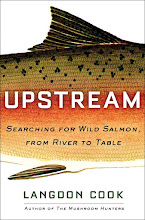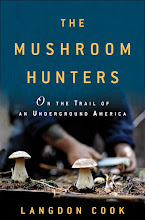
I knew I was on the right track. Off in the woods the voices of Eastern Europeans sing-songed back and forth. A moment later two lanky men came bounding down the mountain with full grocery bags. "We are finding the porcini," one of them admitted to me warily. I continued up. On top of the ridge the forest gave way to the stumps of an old clearcut and the dense growth of new firs. Huckleberry bushes glowed red in slanting afternoon light. More voices and a rustling of brush. A trio burst out of the undergrowth and landed on the trail in front of me. They looked like they'd just stepped off a Hollywood set for some low-budget gypsy movie: two stout women with heavily lined faces attired in peasant dresses and kerchiefs; an older man, sinewy and graying. They all held 5-gallon buckets piled high with giant mushrooms. A moment of indecision. They were surprised to see me and looked ready to flee. "Mushrooms," I said, stating the obvious, and they nodded furtively. I wanted to take their picture but thought better of it. We all looked at each other some more and then they eased their way back into the bush and out of sight. Eastern Europeans are mad about mushrooms. Those who immigrate to this country must think they've woken up in heaven, because there is so much porcini and so little competition. They pick huge amounts of several species that the rest of us ignore, or mostly ignore. Like these scabrous Leccinums, so named because of the diagnostic scabers on the stem.
Eastern Europeans are mad about mushrooms. Those who immigrate to this country must think they've woken up in heaven, because there is so much porcini and so little competition. They pick huge amounts of several species that the rest of us ignore, or mostly ignore. Like these scabrous Leccinums, so named because of the diagnostic scabers on the stem.
Scabrous. Doesn't sound too delectable. Would you eat a mushroom with "scrabous tufts" on it? In fact, this is how mycologists describe the raised bumps on the stem of Leccinum mushrooms. The genus Leccinum is a member of that same bolete family that boasts so many globally famous edibles, including the porcini of Italy. But they are not the equal of the king bolete, Boletus edulis. I like to dry Leccinums to concentrate the flavor, then grind them up into powder to enhance soups and stews. When cooked fresh in the pan they will often turn an unappetizing gray—or even black in an iron skillet. Their texture is not as firm as the king bolete, their flavor not as pleasing. But the Poles and Russians and Czechs and a host of other nationalities across Eastern Europe gobble them down anyway. These boletivores just can't get enough of their beloved Bolitaceae.
Here's what MushroomExpert.com's Michael Kuo says about Leccinums:
...while recognizing that a bolete is a Leccinum is usually relatively easy, figuring out what species you have found can be truly frustrating. In fact, if you are a North American collector at this point in time, it is probably not possible to identify most Leccinum species with scientific certainty... If this reality frustrates you, I'm sorry--but try looking at it this way: this is an exciting time to be collecting Leccinum, and amateur mushroomers and mushroom clubs are in a position to make substantial and important contributions to mycology.
 According to a mycologist who identifies mushrooms for the Puget Sound Mycological Society, the Leccinums at the top are all Leccinum aurantiecum, one of the better edibles in the genus. I'm pretty sure I've been eating this one for a number of years, along with another species called Leccinum manzanitae, which may well be represented by the next image below the top, one of the many Leccinums I found in the vicinity of Vaccinium and in the company of those Eastern Europeans. However, if you read through Kuo's remarks, you'll see there is much debate about the nomenclature. Happily, all the Leccinums are edible, if not all delicious—with one important caveat: it seems a small percentage of the population at large, for reasons not entirely understood, is allergic to the mushrooms in this genus. As with any wild fungi landing on your plate for the first time, try a small portion first.
According to a mycologist who identifies mushrooms for the Puget Sound Mycological Society, the Leccinums at the top are all Leccinum aurantiecum, one of the better edibles in the genus. I'm pretty sure I've been eating this one for a number of years, along with another species called Leccinum manzanitae, which may well be represented by the next image below the top, one of the many Leccinums I found in the vicinity of Vaccinium and in the company of those Eastern Europeans. However, if you read through Kuo's remarks, you'll see there is much debate about the nomenclature. Happily, all the Leccinums are edible, if not all delicious—with one important caveat: it seems a small percentage of the population at large, for reasons not entirely understood, is allergic to the mushrooms in this genus. As with any wild fungi landing on your plate for the first time, try a small portion first.The firm buttons in the top photo got sauteed for a red sauce, while the larger, more mature mushrooms I sliced up and dried.







1 comment:
Sigh. Someday it will rain in California and we will have mushrooms. Someday.
Post a Comment